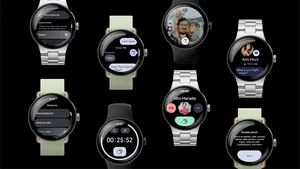Loss of Pulse Detection: A first-of-its-kind feature on Pixel Watch 3
Updated February 26, 2025
Loss of pulse occurs when the heart suddenly stops beating. It’s a health emergency, where every minute matters. It can affect people of any age and be due to a wide range of problems inside or outside the heart, such as primary cardiac arrest, respiratory or circulatory failure, overdose or poisoning. 1 Pixel Watch 3 introduces a first-of-its-kind Loss of Pulse Detection feature to help people receive emergency care in these situations, even if they’re alone and unable to make the call themselves. 2
Getting help from emergency medical services or other trained professionals quickly is critical, but that usually relies on a bystander to recognize the situation and provide or call for help. Unfortunately, many loss of pulse incidents happen when a person is alone, leaving them with effectively no chance of receiving help.
Loss of Pulse Detection on Pixel Watch 3 is an opt-in feature that has the ability to detect loss of pulse and automatically place a call to emergency services if you are unresponsive to provide potentially life-saving care. 3 Here’s why we created Pixel Watch 3’s Loss of Pulse Detection feature to fill that gap, and how it works.
Example of the user flow for the Loss of Pulse Detection feature.
How our Loss of Pulse Detection feature works
Loss of Pulse Detection combines signals from Pixel Watch 3’s sensors, AI and signal-processing algorithms to detect loss of pulse events, with a thoughtful design — built from user research — to limit false alarms. The feature uses signals from the Pixel Watch 3’s existing Heart Rate sensor, which uses green light to check for a user’s pulse.
If the feature detects signs of pulselessness, infrared and red lights also turn on, looking for additional signs of a pulse, while the motion sensor starts to look for movement. An AI-based algorithm brings together the pulse and movement signals to confirm a loss of pulse event, and if so, triggers a check-in to see if you respond.
The check-in asks if you’re OK while also looking for motion. If you don’t respond and no motion is detected, it escalates to an audio alarm and countdown. If you don’t respond to the countdown, the LTE watch or phone your watch is connected to automatically places a call to emergency services, and shares an automated message that no pulse is detected along with your location.
Our goal is to make a difference and contribute towards saving lives. While Loss of Pulse Detection won’t detect every loss of pulse event, we believe it can make a meaningful difference, providing help when it counts most to people and their loved ones.
Loss of Pulse Detection will be available on Pixel Watch 3 in September in various countries in Europe, including the U.K., France, Austria, Denmark, Ireland, the Netherlands, Norway, Sweden and Switzerland. We’ll continue working with regulatory bodies to make the feature available in more countries.
How we developed and tested Loss of Pulse Detection
Our goal has been to build a potentially life-saving feature, and to develop it responsibly. Because loss of pulse events are timely but relatively rare emergencies, they can’t easily be observed, reproduced and tested in real-world settings. We had to find other ways to collect enough data to develop the feature to detect true loss of pulse events.
Loss of Pulse Detection combines signals from Pixel Watch 3’s sensors, AI and signal-processing algorithms to detect loss of pulse events. [Caption updated Aug 20]
The breakthrough came when we used AI and digital signal processing, together with data collected in clinical settings. We worked with cardiologists, gaining unique insights into how a loss of pulse manifests on the watch, that informed our AI algorithm that detects these time-sensitive events. We then tested the algorithm using hundreds of thousands of hours of real-life user data from a diverse group of people.
Finally, to validate that our technology could function in real-life emergency situations, we partnered with stunt actors to simulate real-world circumstances of loss of pulse. The actors wore tourniquets to artificially induce pulselessness, and then simulated the types of falls that would mimic a person suddenly losing their pulse.
Of course, creating a responsible solution goes beyond algorithms. We’ve also been working with emergency medical service providers, dispatchers, paramedics and other experts, getting feedback and ideas along the way to ensure what we’re building is as helpful to our users and the wider emergency medical service ecosystem as possible.
Loss of Pulse Detection is part of our broader effort to make Pixel Watch a guardian of your health and safety. It joins other features like Irregular Heart Rhythm Notifications, which can check for signs of atrial fibrillation; Safety Check, which allows you to set a timer on your device when you feel unsafe to then send your location to a loved one if you don’t respond; and Fall and Car Crash Detection, which can check in and call for help if you fall or are in an accident.










